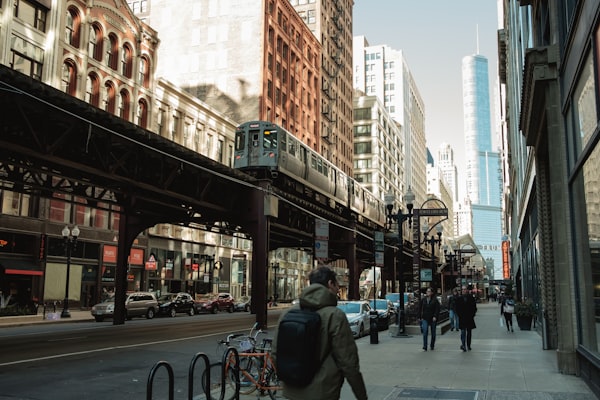Founding Companies
In "1863, three corporations dominated Chicago’s streetway for the remainder of the century: City Railway serving the south side, West Division operating on the city’s west side, and North Chicago controlling the north side." (Young, 1998, p.37)
"Just like the railroads, new street railways were forced early on to adopt incorporated
joint-stock companies to finance the required up-front investment of $1,000 or more per mile to lay down tracks. (Young, 1998, p. 30)" Source
These corporations were setup mostly by other railroad companies and local investors. Not much hassle was in the way for them to lay down rail and connect the city. We are still using some of the same lines they setup starting in 1863.
In 1915 Chicago Elevated Rail Lines started elevating the rail lines.
:no_upscale()/cdn.vox-cdn.com/uploads/chorus_asset/file/9295441/cta_1894.jpg)
The Lake Street Elevated Railroad
The New Deal plans which funneled Federal Reserve (started 1913) money into Government Programs allowed Chicago to spend $288 million on the city street's and infrastructure, taking over private enterprises slowly as Uncle Sam became your transit provider and the monopoly of transit. Old systems do not work forever, there is always a better way. Forcing government systems such as the New Deal streets and changes, and now the CTA down Chicago's throat eliminated businesses and replaced them with public entities which have done nothing to improve things in 80 years.
Actually the government subsidization of these old transit system is a melting pot for vagrants and those that are satisfied with a nasty pissed on train. You can only handle the CTA for so long. Convenient when young, but boy does that get old.
Even scary to this day near the area of the Brown Line Disaster during Rush Hour or on the Red Line if someone 'off-putting' sits next to you.
If you look, the same designs are still in use outside of the addition of the electric 3rd rail. If you've seen a section of the tracks today you can see similar engineering.
Great Depression and Government Takeover
"As a private entity, Chicago’s transit railway system could not generate the capital needed to stay competitive in a changing transit market. "The L's managers found themselves starved for capital to expand and to modernize the line just as the automobile appeared on the scene as a competitor. New Deal policy enabled Chicago to spend more than $288 million between 1915 and 1930 on street construction, widening, and paving, but the elevated railway system over the same span was able to finance through private borrowing only $36.9 million in improvement and extensions." Source
The New Deal allowed Chicago to spend $288 million on the city street's and infrastructure, taking over private enterprises slowly as they became the monopoly of transit. Transit would have evolved and Chicago would not have perished with the fierce competition and liquidations in the transit market.
Old systems do not work forever, there is always a better way. And forcing government systems such as the CTA down Chicago's throat which in turn eliminated businesses and replaced them with public entities has done nothing to improve things in 80 years.
Actually the government subsidization of these old transit system is a melting pot for vagrants and those that are satisfied with a nasty pissed on train. You can only handle the CTA for so long. Convenient when young, but boy does that get old.
Even scary to this day near the area of the Brown Line Disaster during Rush Hour.
Modern Day Trains
Made by private enterprise, Nippon Sharyo made most of the heavy rail cars in Chicago used today by Metra.
Also the light rail cars on the CTA elevated and light rail are mostly Bombardier 5000 Series
Primary Source:
[1] https://utc.uic.edu/wp-content/uploads/Central-Area-Circulation-History-Final-Version-Reduced.pdf

[ This content also posted on Hive. HERE ]


